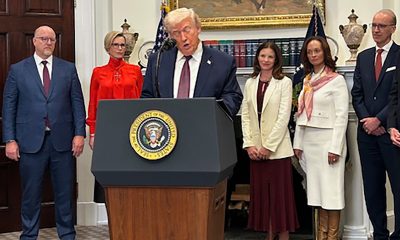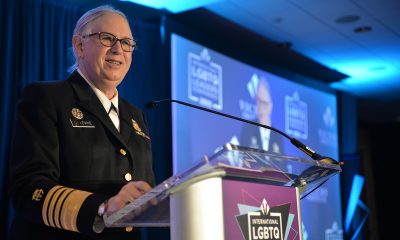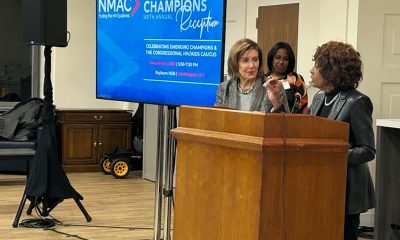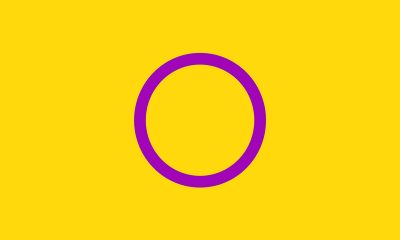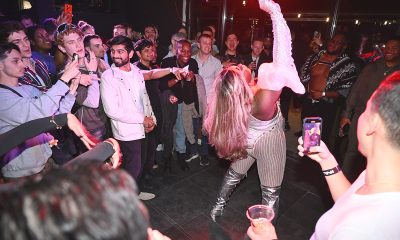Local
Protesters return to Smithsonian after ban lifted
‘Censored’ video triggered action; ‘Hide/Seek’ closes Sunday
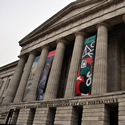
Two activists detained in December after protesting a decision by the Smithsonian Institution to remove a video from the “Hide/Seek” exhibit about gay art in America were officially permitted to return to the National Portrait Gallery, site of the exhibit, for a private tour sponsored by Washington Blade on Feb. 3.
After intervention by the Blade, David Ward, co-curator of the exhibit, agreed to seek an official end of the enforcement of any “ban” by Smithsonian security officials barring the two protesters — videographer/photographer Mike Iacovone, who is straight, and Mike Blasenstein, who is gay — from entering any Smithsonian museum. The two were detained following their protest of a decision in late November by Smithsonian Secretary Wayne Clough to remove a four-minute video, an extract from a longer video by the late gay artist David Wojnarowicz, who died of AIDS in 1993, showing for a few seconds ants crawling on a crucifix, imagery that a right-wing group, the Catholic League, claimed to be anti-Catholic.
They were detained when Blasenstein and Iacavone entered the National Portrait Gallery and Blasenstein displayed the video on an iPad hung around his neck. He was also holding a stack of fliers with text explaining his protest at the video’s removal from the exhibit. Iacaone was then also detained by Smithsonian police for filming Blasenstein’s run-in with security. Each was released but only after being made to sign letters pledging not to return to any Smithsonian facilities.
Explaining his decision to protest, Blasenstein later told the newsletter ArtInfo, that he joined in actions critical of the removal of the video because, he said, “I just felt this was an important issue.”
“I’m not really an artist or an activist,” Blasenstein said, “but when I heard that they took it down, it just seemed to send such a clear negative message. So I thought to myself, I would send my own message and bring this art back into the museum.”
Blasenstein later told the Blade that they were not only banned from the museum but during their detention they were “forcibly stripped of our materials, handcuffed, dragged into a stairwell, and told to sign papers thrust in front of us or be arrested.” They were then escorted from the building, he said, “without being given copies of what we had signed.”
Ward, an historian at the Portrait Gallery and co-curator of the exhibit with Jonathan D. Katz of the State University of New York in Buffalo, told the Blade that the ban was actually “never imposed” by the Smithsonian, but was instead “done by D.C. Metro,” the city’s police force, which was called to the scene, “without our knowledge or acquiescence.”
“They then passed the buck back to us to make us ‘lift’ a ban that wasn’t our doing,” he said. Ward personally welcomed both Iacovone and Blasentein to the exhibit for the private tour on behalf of the Blade, saying, “I hope this is the end of it.” He also stated he wanted to “move on” from the entire controversy over the edited video, one of 105 items in the exhibit, which opened in late November, and closes on Feb. 13.
Blasentein told the Blade that he never felt the ban was purely a paper reprimand, saying, “let me tell you, when everyone around you is wearing guns, nothing about the process feels ‘bureaucratic.'” He said that though “you could spend hours untangling this thing” Ward was correct to insist that the so-called ban was really triggered by the city’s police, but he added that “the sergeant I spoke to at MPD was pretty clear in his opinion that MPD doesn’t ban anybody, but merely enforces a ban on behalf of the property owner.” He also stressed that the Smithsonian management “to the best of our knowledge” never insisted on barring them from the museum. That action, he believes, “was solely a decision of Smithsonian police.”
Blasentein said that “the story here is not primarily our ban,” but rather the act of official censorship itself. However, he insists that “had we been allowed back into the building,” after the incident with the iPad and the leaflets, “our protest would have been a lot different.”
“The only reason a trailer is parked outside the National Portrait Gallery is because that was the closest we were legally allowed to get to the building. If the Smithsonian had let me stand there for seven and a half hours with the iPad, we would have mobilized volunteers to do the same every day until Feb.13,” the day the exhibit closes its doors.
Instead, Iacovone and Blasenstein secured paperwork from the city to park a trailer directly in front of the museum at its entrance in the 700 block of F Street, N.W., where what they call the Museum of Censored Art — to show “the art the Smithsonian won’t,” will remain open until Sunday from 11:30 a.m. to 7 p.m. Even though they can now legally enter the museum, Iacovone said their counter-exhibit in the trailers will continue to remain open, staffed by 12-15 volunteers through Sundayt.
Iacovone said they have spent more than $6,500 so far on trailer and parking space costs and for powering batteries to run the video player. He praised two art galleries — the Hamiltonian and Flashpoint, as well as two others, Transformer and Civilian — for assisting them in various ways. More than 4,000 people have entered the trailers and viewed the video, he said, noting that “our biggest day so far was over 500 people,” and he thinks by the time the Museum of Censored Art shuts down they will reach the 5,000-visitor mark.
The exhibit is the first on the subject of same-sex desire in American art and shows the work of noted artists Thomas Eakins and John Singer Sargent as well as more recent icons such as Jasper Johns, Andy Warhol and Robert Mapplethorpe, the latter a photographer whose photo images showing explicit male sexuality caused the Corcoran Gallery to halt the exhibit planned of his work more than 20 years ago.
Smithsonian secretary G. Wayne Clough, the official responsible for the decision to order removal of the video, part of a larger work in 1987 called “A Fire in My Belly,” meanwhile, has been the target of calls for him to resign in the wake of that decision. Last week, about 30 protesters rallied outside the Smithsonian Castle on the Mall during a quarterly meeting of the Smithsonian Board of Regents, to demand that they fire him.
Organized by Art+ (positive), a New York City-based group that fights censorship and homophobia, and backed also by the activist group, People For the American Way, protesters declared that Clough had given in to right-wing pressures and should step down. They chanted “Hey, hey, ho, ho, Clough must go!” and “Ants in my pants, fire in my belly — Clough has got to go!”
The regents, however, announced after their meeting that they supported Clough, though even he subsequently acknowledged that perhaps it had been made in haste and that he would respond differently in the future.
“I’d like to think I’m a little wiser than I was six months ago or three months ago,” he said at a news conference following the meeting with the regents, which reviewed the entire controversy and then issued a statement backing him. However, a three-member panel reporting to the regents implicitly criticized the way the censorship decision was made and communicated. And regents repeatedly asked by reporters whether Clough had made the right decision refused to answer directly.
Another rebuke, this time more direct, came from the board of a Smithsonian member institution, the Hirshhorn Museum and Sculpture Garden, that met last week and issued an open letter, saying they were “deeply troubled by the precedent” of the November decision to pull the video from the show.
District of Columbia
Reasons to be optimistic about 2026
Local thought leaders offer hope for the New Year
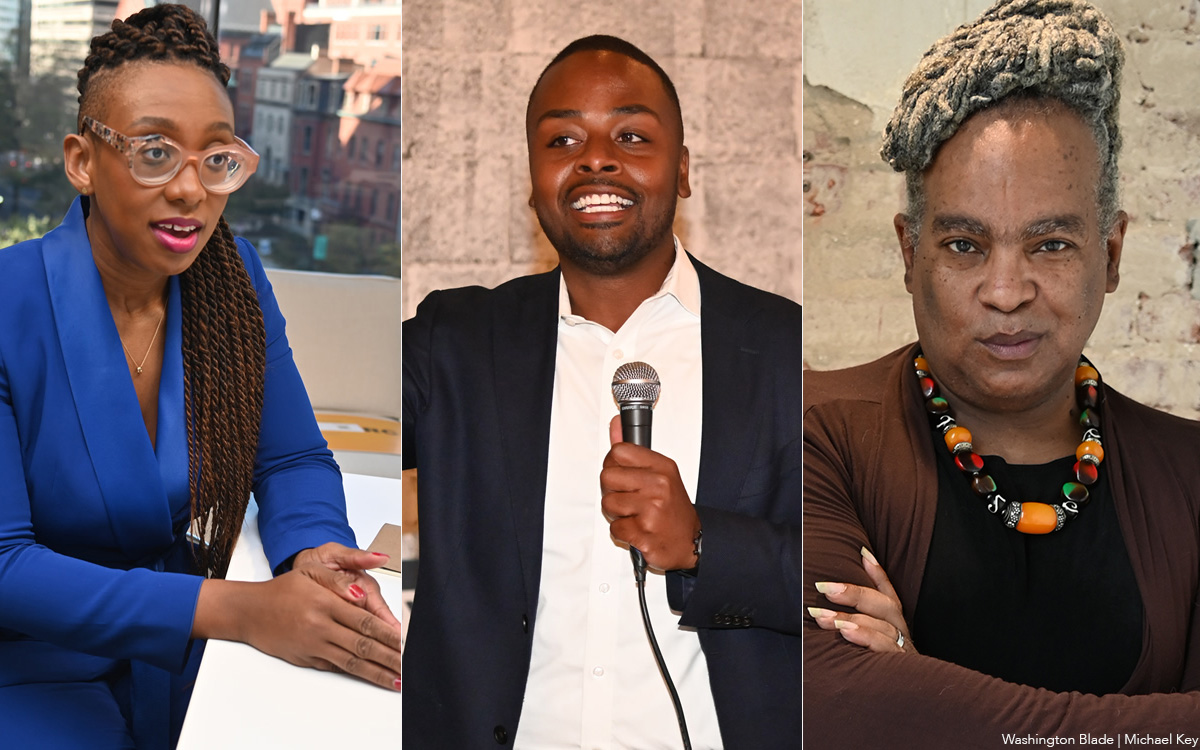
It was a year like no other. It began with Donald Trump’s inauguration in January 2025 and included a takeover of D.C. police, ICE raids, challenges for the local economy, and other events that have many queer Washingtonians ready for 2026.
As we prepare to welcome the New Year, the Blade asked a range of local thought leaders about what makes them optimistic for 2026. Here are their responses.
June Crenshaw
Deputy Director, Capital Pride Alliance
What gives me optimism for 2026 is the way our LGBTQIA2S+ community supports one another – across identities, neighborhoods, and movements – and because we continue to build our collective powers; we demand and create safer, more inclusive spaces.
Zachary Parker
Ward 5 DC. Council member
I’m optimistic about the upcoming elections and the District’s continued fight for local autonomy. One thing I know for sure is that Washingtonians are tough and persistent, and we’re ready to face any challenge as we keep fighting for D.C. statehood.
Sister Jeannine Gramick
Co-founder of LGBTQ supportive New Ways Ministry
As a nun who thinks politically about the Catholic Church, I’m extremely optimistic that Pope Leo XIV will continue to welcome LGBTQ people. At the conclave, most cardinals knew Pope Francis had (then) Cardinal Proost in mind!
Adam Ebbin
Virginia State Senator representing parts of Arlington, Alexandria, and Fairfax Counties
I am excited about 2026 bringing the return of the pro-equality governor to Virginia. I believe that Abigail Spanberger will be a champion for LGBT people and it will also be the year that we can finally pass the necessary legislation to send a constitutional amendment to the voters that would guarantee marriage equality in the Virginia Constitution.
Howard Garrett
President, Capital Stonewall Democrats
In 2026, our community can be optimistic because we’ve proven, again and again, that when we organize, we win: at the ballot box, in the courts, and in our neighborhoods. Even amid challenge, LGBTQ+ Washingtonians and our allies are building stronger coalitions, electing champions, and advancing real protections that make daily life safer and more affirming for everyone.
Paul Kuntzler
D.C. LGBTQ activist since the early 1960s, co-founder of Capital Stonewall Democrats
Last Nov. 4, 11 states held elections and Democrats won almost all of the elections. Next Nov. 3, 2026, Democrats will win control of both the House and Senate …An Economist poll reported that 15 percent to 20 percent of those who voted for Trump no longer support him. The results of the elections of Nov. 3, 2026, will be the beginning of the end of Trump and his racist and criminal regime.
Kelley Robinson
President, Human Rights Campaign
This past year has brought relentless attacks against the LGBTQ+ community, but it has also shown the resiliency of queer folks. While this administration has worked tirelessly to oppress us, we’ve met that oppression with courage. As we step into 2026, my hope is that we carry that energy forward and continue protecting one another, fighting back against injustice, and celebrating queer joy. If 2026 is anything like 2025, we know the challenges will be intense, but our community is more determined than ever to meet hate with resilience, and to turn struggle into strength.
Freddie Lutz
Owner, Freddie’s Beach Bar in Arlington and Rehoboth Beach
I am optimistic that the current president will fulfill his promise to boost the economy. We are all suffering – businesses in D.C. I just read it is 17 to 18 percent down. And I’m hoping the president will boost the economy. I always try to remain optimistic.
Nicholas F. Benton
Owner & Editor, Falls Church News-Press
My optimism stems from my belief in the human capacity and generosity of spirit. Those who are committed to those qualities will find a way.
Richard Rosendall
Former president, D.C. Gay & Lesbian Activists Alliance
MAGA efforts to demonize LGBTQ people are dangerous but will fail overall because understanding and acceptance have grown and endured. The blue wave in November 2026 will show this.
TJ Flavell
Organizer, Go Gay DC
Hope springs eternal. Nurturing your own wellness is vital to the New Year, including enjoying social and cultural activities through such groups as Go Gay DC – Metro DC’s LGBTQ Community. Also, 2026 ushers in a new tax deduction for charitable giving. Check the IRS website for details. You can make a positive impact in the New Year by supporting good charitable causes like the D.C. LGBTQ+ Community Center, a safe, inclusive, and affirming space where all members of our community can thrive.
Rayceen Pendarvis
Leader of Team Rayceen D.C. LGBTQ support organization
I have experienced many trials and tribulations in my lifetime, throughout which my spirit has enabled me to find peace despite the turbulence around me. Being optimistic allows me to be a beacon of light for those who may be lost in the darkness.
Zar
Team Rayceen organizer
My reason for optimism is this: death. Life is a cycle of time, change, and destruction. Everything is impermanent; the time any person rules is finite and eventually all empires end.
DJ Honey
Team Rayceen supporter
Despite the noise, I see 2026 as a year where queer people continue choosing community over isolation. Even when challenged, our culture keeps evolving. We are more visible, more creative and intentional about building spaces that protect each other and center joy without asking permission.
Nick Tsusaki
Owner, Spark Social House, D.C. LGBTQ café and bar
I’m optimistic for 2026 because it feels like the tide is turning and we’re coming together as a community.
District of Columbia
Rush reopens after renewing suspended liquor license
Principal owner says he’s working to resolve payroll issue for unpaid staff
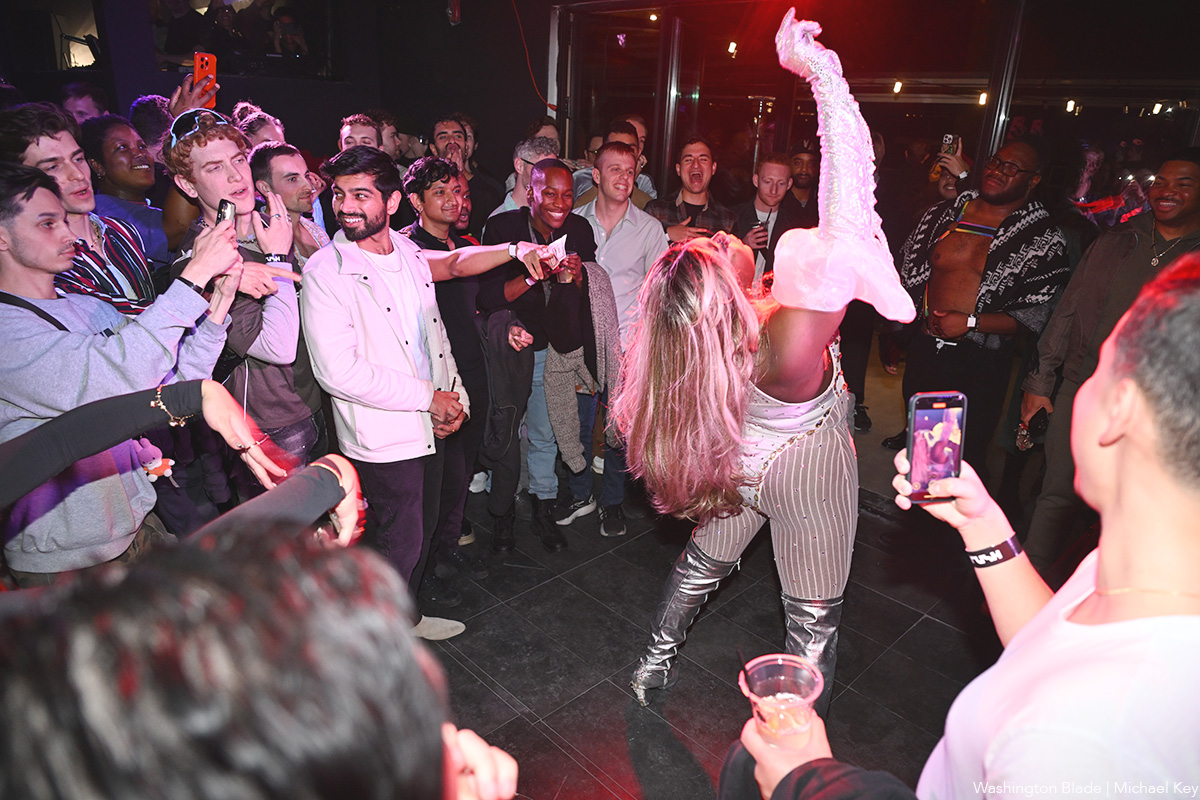
The D.C. LGBTQ bar and nightclub Rush reopened and was serving drinks to customers on Saturday night, Dec. 20, under a renewed liquor license three days after the city’s Alcoholic Beverage and Cannabis Board suspended the license on grounds that Rush failed to pay a required annual licensing fee.
In its Dec. 17 order suspending the Rush liquor license the ABC Board stated the “payment check was returned unpaid and alternative payment was not submitted.”
Jackson Mosley, Rush’s principal owner, says in a statement posted on the Rush website that the check did not “bounce,” as rumors circulating in the community have claimed. He said a decision was made to put a “hold” on the check so that Rush could change its initial decision to submit a payment for the license for three years and instead to pay a lower price for a one-year payment.
“Various fees and fines were added to the amount, making it necessary to replace the stop-payment check in person – a deadline that was Wednesday despite my attempts to delay it due to these circumstances,” Mosley states in his message.
He told the Washington Blade in an interview inside Rush on Saturday night, Dec. 20, that the Alcoholic Beverage and Cannabis Administration (ABCA) quickly processed Rush’s liquor license renewal following his visit to submit a new check.
He also reiterated in the interview some of the details he explained in his Rush website statement regarding a payroll problem that resulted in his employees not being paid for their first month’s work at Rush, which was scheduled to take place Dec. 15 through a direct deposit into the employees’ bank accounts.
Several employees set up a GoFundMe appeal in which they stated they “showed up, worked hard, and were left unpaid after contributing their time, labor, and professional skills to Rush, D.C.’s newest LGBTQ bar.”
In his website statement Mosley says employees were not paid because of a “tax related mismatch between federal and District records,” which, among other things, involves the IRS. He said the IRS was using his former company legal name Green Zebra LLC while D.C. officials are using his current company legal name Rainbow Zebra LLC.
“This discrepancy triggered a compliance hold within our payroll system,” he says in his statement. “The moment I became aware of the issue, I immediately engaged our payroll provider and began working to resolve it,” he wrote.
He added that while he is the founder and CEO of Rush’s parent and management company called Momentux, company investors play a role in making various decisions, and that the investors rather than he control a “syndicated treasury account” that funds and operates the payroll system.
He told the Blade that he and others involved with the company were working hard to resolve the payroll problem as soon as possible.
“Every employee – past or present – will receive the pay they are owed in accordance with D.C. and federal law,” he says in his statement. “That remains my priority.”
In a follow-up text message to the Blade on Sunday night, Dec. 21, Mosley said, “All performers, DJs, etc. have been fully paid.”
He said Rush had 21 employees but “2 were let go for gross misconduct, 2 were let go for misconduct, 1 for moral turpitude, 2 for performance concerns.” He added that all of the remaining 14 employees have returned to work at the time of the reopening on Dec. 20.
Rush held its grand opening on Dec. 5 on the second and third floors of a building at 2001 14th Street, N.W., with its entrance around the corner on U Street next to the existing LGBTQ dance club Bunker.
With at least a half dozen or more LGBTQ bars located within walking distance of Rush in the U Street entertainment corridor, Mosley told the Blade he believes some of the competing LGBTQ bars, which he says believe Rush will take away their customers, may be responsible along with former employees of “rumors” disparaging him and Rush.
Rehoboth Beach
Rehoboth’s Blue Moon is for sale but owners aim to keep it in gay-friendly hands
$4.5 million listing includes real estate; business sold separately
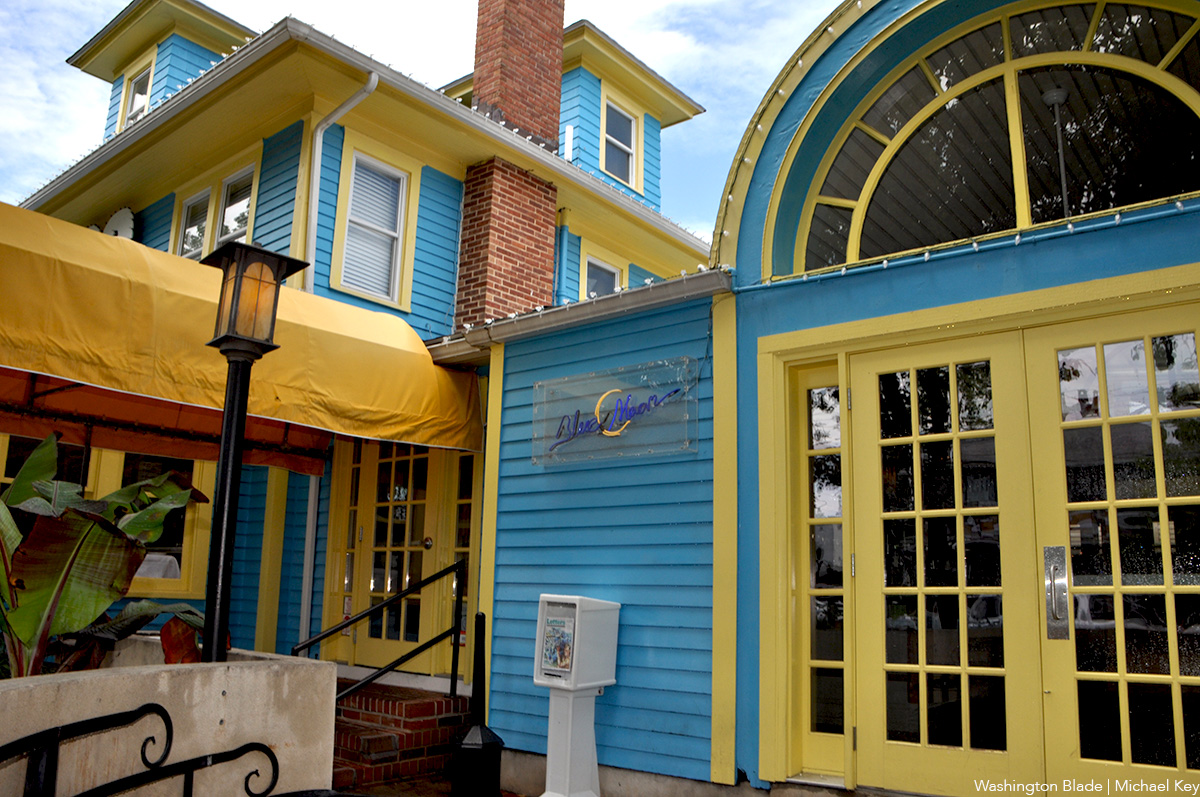
Gay gasps could be heard around the DMV earlier this week when a real estate listing for Rehoboth Beach’s iconic Blue Moon bar and restaurant hit social media.
Take a breath. The Moon is for sale but the longtime owners are not in a hurry and are committed to preserving its legacy as a gay-friendly space.
“We had no idea the interest this would create,” Tim Ragan, one of the owners, told the Blade this week. “I guess I was a little naive about that.”
Ragan explained that he and longtime partner Randy Haney are separating the real estate from the business. The two buildings associated with the sale are listed by Carrie Lingo at 35 Baltimore Ave., and include an apartment, the front restaurant (6,600 square feet with three floors and a basement), and a secondary building (roughly 1,800 square feet on two floors). They are listed for $4.5 million.
The bar and restaurant business is being sold separately; the price has not been publicly disclosed.
But Ragan, who has owned the Moon for 20 years, told the Blade nothing is imminent and that the Moon remains open through the holidays and is scheduled to reopen for the 2026 season on Feb. 10. He has already scheduled some 2026 entertainment.
“It’s time to look for the next people who can continue the history of the Moon and cultivate the next chapter,” Ragan said, noting that he turns 70 next year. “We’re not panicked; we separated the building from the business. Some buyers can’t afford both.”
He said there have been many inquiries and they’ve considered some offers but nothing is firm yet.
Given the Moon’s pioneering role in queering Rehoboth Beach since its debut 44 years ago in 1981, many LGBTQ visitors and residents are concerned about losing such an iconic queer space to redevelopment or chain ownership.
“That’s the No. 1 consideration,” Ragan said, “preserving a commitment to the gay community and honoring its history. The legacy needs to continue.” He added that they are not inclined to sell to one of the local restaurant chains.
You can view the real estate listing here.

